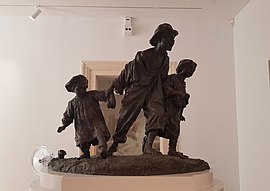Les Gavroches
| Les Gavroches | |
|---|---|
 The sculpture at MUŻA | |
| Artist | Antonio Sciortino |
| Completion date | 1904 |
| Medium | Bronze |
| Subject | Street children |
| Dimensions | 92 cm × 150 cm × 124 cm (36 in × 59 in × 49 in) |
| Location | MUŻA, Valletta, Malta |
| Owner | Government of Malta |
Les Gavroches is a bronze sculpture by
History
Sciortino completed Les Gavroches in 1904 while he was living in Rome.[1] By the following year, the sculpture had been exhibited in Rome and Paris.[2] It was eventually taken to Malta by the Society of Arts, Manufacturers and Commerce, at a cost of £120 including packing and dock charges.[1]

In 1907, the society presented the statue to the government,[3] and it was inaugurated in the Upper Barrakka Gardens.[1] The sculpture's base contains an inscription commemorating the society's donation of the statue.[3] During World War II, it was removed in order to ensure its safety, but it was put back in place after the war ended.[3]
On 16 January 1951, Prime Minister George Borg Olivier presented a small bronze model of Les Gavroches made by Sciortino to Princess Elizabeth (who became Queen Elizabeth II) in a ceremony held at Auberge d'Aragon.[3]
Due to exposure to the elements, the statue suffered some deterioration over the years.
A replica of the statue was later placed in its original location at the Upper Barrakka.[5] In 2012, environment and culture minister Mario de Marco selected Les Gavroches as Malta's top treasure to be added to Europeana.[6][7]
Description

Les Gavroches represents three street children from Paris during the time of the French Revolution of 1848.[2] The subject and title are inspired by the character Gavroche from Victor Hugo's 1862 novel Les Misérables.[2] The sculpture represents the themes of hope and innocence, highlighting the younger generation's aspirations for freedom and progress.[6]
The sculpture shows influence from Impressionism and the work of Auguste Rodin.[2] The statue is one of Sciortino's early works since it was created when he was 24 years old,[7] and it is regarded as one of finest masterpieces.[2][5]
Legacy
Les Gavroches was depicted on a 1s6d Malta stamp issued in 1956,[8] on a £M 100 gold coin minted in 1977,[9] and on €10 silver and €50 gold coins minted in 2012.[10] It was also depicted on a Telemalta phone card.[1]
See also
References
- ^ a b c d e f Cini, George (9 June 2003). "Banishment for Les Gavroches masterpiece". Times of Malta. Archived from the original on 14 February 2020. Retrieved 14 February 2020.
- ^ a b c d e f g "Les Gavroches". Europeana. Archived from the original on 14 February 2020. Retrieved 14 February 2020.
- ^ a b c d Simpson, Donald H. (1957). "Some public monuments of Valletta 1800-1955 (1)" (PDF). Melita Historica. 2 (2): 73–87. Archived from the original (PDF) on 22 January 2019. Retrieved 14 February 2020.
- ^ Micallef, Antonia (17 November 2018). "MUŻA: One of 13 new European museums worth a visit – 'The Guardian'". TVM. Archived from the original on 14 February 2020. Retrieved 14 February 2020.
- ^ a b "Sciortino Exhibition extended". The Malta Independent. 9 September 2007. Archived from the original on 14 February 2020. Retrieved 14 February 2020.
- ^ a b "EU ministers pick their top treasures - Malta's choice is Les Gavroches". Times of Malta. 8 May 2012. Archived from the original on 14 February 2020. Retrieved 14 February 2020.
- ^ a b "De Marco picks Les Gavroches for Europeana's top treasures". Malta Today. 8 May 2012. Archived from the original on 14 February 2020. Retrieved 14 February 2020.
- ^ "1s6d Definitive 1956 – Les Gavroches statue, deep turquoise-green". Malta Philately. Archived from the original on 14 February 2020. Retrieved 14 February 2020.
- ^ "6th series – Les Gavroches bronze sculpture". Central Bank of Malta. Archived from the original on 23 December 2016. Retrieved 14 February 2020.
- ^ "Europa Programme 2012 with the theme 'European Artists' – Antonio Sciortino (1879–1947)". Central Bank of Malta. Archived from the original on 9 December 2015.
External links
 Media related to Les Gavroches (Antonio Sciortino) at Wikimedia Commons
Media related to Les Gavroches (Antonio Sciortino) at Wikimedia Commons

